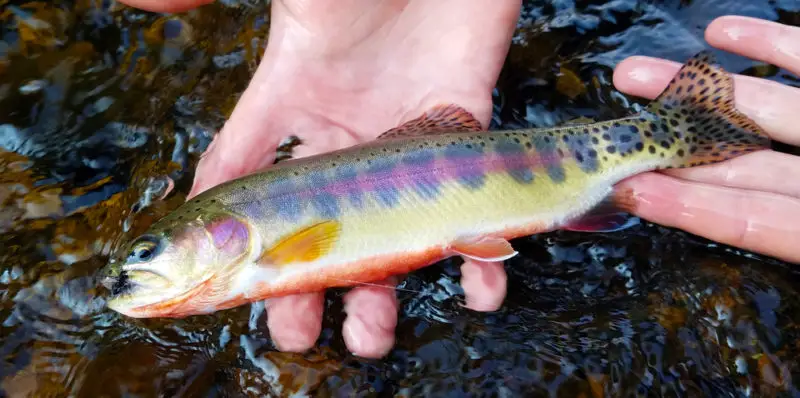Golden trout are beautiful fish that are native to the high country of the Sierra Nevada mountains in central California. Since the first California Golden trout was classified in 1892, humans have been transplanting them to new waters both in California and in other western states.
The Utah Utah Division of Wildlife Resources has been planting golden trout in some of the state’s high-mountain lakes since the 1920s. Back then, the Utah DWR planted Goldens in Atwood Basin, which is in the headwaters of the Uinta River in the Uinta Mountains. Subsequently, through the years, Utah fisheries officials have planted more golden trout in headwater lakes of Atwood Creek along with a headwater lake of the Duchesne River and another in the Ashley Creek headwaters. These are also in the Uinta Mountains. We’ll talk more about that in the paragraphs below. Also, See
One more item that I’ll mention here is that the last time the UDWR planted golden trout in the state was in 2014. The reason for this is that a fish pathogen was discovered in the broodstock where they had been obtaining their golden trout. To date, they have not procured a different source.

Uinta Mountains
The Uinta Mountains lie 100 miles east of Salt Lake City. These mountains hold the distinction of being the tallest east-west mountain range in the contiguous United States. Uinta mountain peaks range from 11,000 to 13,528 feet above sea level. This range of mountains holds vast tracts of roadless wilderness and over 1,000 natural backcountry lakes. Over half of these support populations of game fish.
Golden Trout Characteristics
Golden trout have predominantly golden ribs and golden flanks, which can vary to an almost copper color. They have around 10 dark oval marks called parr marks along each side with orangish or red lateral lines. Their pelvic fins, anal fins, and dorsal fin all have white leading edges. The rear portion of the body in front of the tail is speckled with black spots, as is the dorsal fin. Genetically pure golden trout have very few spots below their lateral lines. On the other hand, Golden Trout x Rainbow trout hybrids have an abundance of spots above and below the lateral line.
Golden’s readily crossbreed with rainbow trout. This is a threat to the continued existence of these fish in their pure form.
The golden trout’s native habitat is not very nutrient-dense. Consequently, adults are relatively tiny fish that range from six to twelve inches in length in their native range. Goldens transplanted to mountain lakes grow much bigger. There are several recorded lake caught Golden trout that weighed in at 11 pounds “5.0 kg ” and more. In fact, the world record Golden trout, which came from Cooks Lake in Wyoming’s Wind River Mountains in 1948, weighed 11.25 lbs.

Native Range of California Golden Trout
Golden trout, which are the state fish of California, are native to Golden Trout Creek, “formerly Volcano Creek,” and the South Fork Kern River. This area is now encompassed by the Golden Trout Wilderness. This is, of course, in the southern Sierra Nevada mountains of California.
The first golden trout to be taxonomically described were caught in 1892 by ichthyologist David Starr Jordan. History buffs know that David Starr Jordan was the first chancellor of Stanford University. Mr. Jordan caught the fish on the southern end of the Sierra Nevada mountains at the Augua Bonita waterfall on Golden Trout Creek, “then Volcano Creek,” which is near its confluence with the South Fork Kern River.
Golden Trout Populations in Utah
Golden trout exist in high mountain lakes in three different river drainages in the Uinta Mountains:
Atwood Basin
As stated in the introduction, golden trout were first stocked in the Atwood Creek drainage in the 1920s. Through the years Utah Division of Wildlife Resources has made additional introductions of golden trout into the Atwood basin. However, since in their native environment, golden trout never had to compete with other fish species, they don’t do well with competition. Many of the introduced populations either completely died out or mostly died out through the years. This is due to their inability to compete with brook trout, which are also an introduced species in the Uintah River drainage. As recently as 2012, the Utah DWR stocked golden trout into Atwood Lake, Mt. Emmons Lake, and Lake U-19. All of these are in Atwood Basin.
The best starting point to reach Atwood Basin is via the Uintah River trailhead, which is located in Uintah Canyon, approximately 25 miles north of Roosevelt, Utah. From the trailhead, it is approximately 18 miles to Atwood Lake.
Note that campfires within 1/4 mile of any lake in Atwood Basin have been prohibited since 2005. Consequently, you’ll need to pack a gas stove to accommodate any cooking that you need to do. Here is a list of areas in the Uinta Mountains where campfires are prohibited.
Echo Lake
In 2013 and 2014, the Utah DWR stocked more than 11,000 5-6 inch golden trout in Echo Lake, which is in Murdock Basin in the Duchesne River drainage. This is in the Uinta-Wasatch-Cache National Forest.
Echo Lake is the best bet for someone who doesn’t want to hike or ride a horse in search of golden trout.
Marsh Lake
To get to Echo Lake from Kamas, Utah, take the Mirror Lake Highway, then take the Murdock Basin Road, which splits off around 27 miles out of town. The road is a bumpy ride and requires a high clearance 4-wheel drive vehicle or an ATV, so plan accordingly.
Marsh Lake, which is the easternmost golden trout water we will talk about, is in the Ashley Creek drainage in the Uinta Mountains. Both the catch-and-keep and the catch-and-release Utah State record golden trout came from Marsh Lake.
The last time Marsh Lake was planted with golden trout was September 24th of, 2014. At that time, the Utah DWR planted 600 goldens, which averaged 1.53 inches long.
Marsh Lake is a unique Utah water in that it has a self-sustaining golden trout population.
Golden trout do not do well with other trout species or char, such as Brook Trout. Brook trout outcompete them for food and habitat, while aggressive fish, such as brown trout feed on their fry. Rainbow trout are closely enough related to golden trout that they readily crossbreed with them. For a population to be self-sustaining, it needs to be removed from competing fish species.
Marsh Lake is northeast of Vernal, Utah. You can get there after some bushwhacking via the Marsh Peak trail, which is accessed off of the Ashley Twin Lake road, which in turn is accessed from the Redcloud loop road.


Utah State Record Golden Trout
The Utah state catch-and-keep record was caught at Marsh Lake by a 13-year-old boy named Isaac Vance in 2019. The fish was 14 ⅞”inches in length and had a 7 ¾ inch girth. The previous Utah state catch and keep golden trout record was set in 1977. This fish came from Atwood Creek and was 14.5″ long and weighed 14 oz.
Jonah Lewis caught the Utah state catch-and-release record golden trout at Marsh Lake in 2020. This fish was 16 ½”long.
Non-native Species in the Uintas
The only trout species that are native to the Uinta mountains are the Colorado River cutthroat trout (Oncorhynchus clarki pleuriticus) and the Bonneville Cutthroat trout (Oncorhynchus clarkii utah). Also see
Bear River cutthroat trout are native to the Bear River drainage. Based on taxonomic observations, they are proposed to be a separate species, but at this time, they are grouped with Bonneville Cutthroat Trout.
Golden Trout (Oncorhynchus aguabonita) are an introduced species in the Uintas. Other introduced species include the following.
Brown Trout
Brown Trout (Salmo trutta), which are native to Europe and Western Asia, came to the United States from Germany in 1883.
Yellowstone Cutthroat Trout
In past years the Utah DWR introduced Yellowstone Cutthroat Trout (Oncorhynchus clarkii), which are native to the drainages of the Yellowstone River and some drainages of the Snake River into some areas in the Uinta Mountains.
Brook Trout
Contrary to their name, Brook trout (Salvelinus fontinalis) are actually a species of Char. These fish are native to eastern North America, from Georgia northward through eastern Canada.
Brook trout thrive in all Uinta Mountain drainages, so much so that they tend to displace native cutthroat trout.
Rainbow Trout
Rainbow trout (Oncorhynchus mykiss) are, according to Wikipedia, native to the cold-water tributaries of the Pacific Ocean in both North America and Asia. These fish are hearty and are easily propagated in hatchery settings. What’s more, they thrive when they are introduced into new environments, so much so that they have been introduced into at least 45 countries. On the downside, rainbow trout tend to outcompete native fish species wherever they are introduced. They also hybridize with closely related species, such as the golden trout. The Rainbow Trout is on the world’s top 100 invasive species list.
Tiger Trout
Tiger trout can occur naturally in the wild but are mainly an artificial hybrid between a female brown trout and a male brook trout.
Splake
The Utah DWR stocks splake, which are a brook trout x lake trout hybrid fish in some Uinta Mountain lakes.
Arctic Grayling
In North America, Arctic grayling (Thymallus arcticus) are native to Canada, Alaska, and certain drainages of the Missouri River in Montana. Wildlife officials have introduced grayling into lakes in the Rocky Mountains of Wyoming, Idaho, and Utah. They are also an introduced species in Washington, Oregon, California, Nevada, and Arizona.
Kokanee Salmon
Kokanee Salmon (Oncorhynchus nerka) are the non-anadromous or, in other words, land-locked form of sockeye salmon. The Utah DWR has stocked these fish in some Utah waters that include the State-line reservoir, which is on the north slope of the Uintas and Flaming Gorge Reservoir.
Recent Posts
The only venomous snakes in Washington State are Northern Pacific Rattlesnakes. The Northern Pacific Rattlesnake (Crotalus oreganus oreganus) is a sub-species of the Western Rattlesnake. Anyone...
Skunks are not classified as true hibernators. But they go into a state of torpor when the weather gets cold. Skunks are light sleep hibernators, along with opossums, bears, and raccoons. ...

